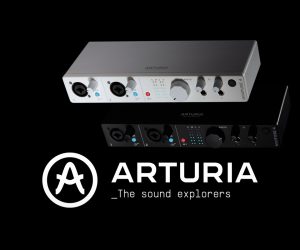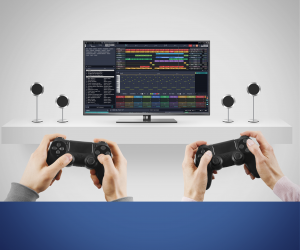
Deadline Music: Tim Tam Truly Madly
Bin your Neumanns and set your grand piano on fire as we go lo-fi for this chokky bikkie ad.
Client: Tim Tams
Song Length: 0:30 seconds
Time To Record: One Day
Final Media: TV Commercial
Tutorial: Blair Joscelyne
How many microphones do you have sitting in your studio right now? And how often do you go for the same setup because it’s what you’re used to? Well, you’re not alone, and knowing what works and what doesn’t is the best way to stay productive when you’re on a deadline or in a hurry… and I am usually in a hurry! I write and record around 10 commercial tracks a week and this doesn’t often leave a lot of time for lengthy experimentation. I often have to rely on tried and tested methods of recording instruments that will result in sonically interesting productions ready to be approved by a client and broadcast on TV within 48 hours. The result of this means my experimentation usually involves processes that make my production quicker rather than slower. Using lapel microphones on instruments, mis-matched stereo pairs, the cheapest microphone that money can buy and limiting the use of plug-ins were all on the agenda for the production of this music track for Arnott’s.
TINY TIM TAM
I recently composed and produced a new piece of music to appear on the TV commercials for everyone’s favourite chocolate biscuit, Tim Tams. The goal was to make a catchy pop song and make it sound as authentically ‘indie’ as possible. What does ‘indie’ mean you ask? I have no idea to be honest but I know it can’t sound like a Celine Dion single. I take ‘indie’ to mean, in this commercial sense, not sounding too ‘expensive’ which contrasts directly with what most of us are striving to do. But how do you get an inexpensive sound when you’re surrounded with the best plug-ins and microphones money can buy? For starters you bin all your good gear (metaphorically speaking) and make some decisions about how you’re going to slim down your production line to make use of a simpler setup. Surprisingly, it was a lot of fun to get back to budget basics. So bin your Neumanns and set your grand piano on fire. Done? Good. Let’s enter the exciting world of budget production.
BUDGET PHILOSOPHY
If you’ve read any of my articles in AT before you’ll probably know that I’m a avid fan of setting limitations to get things done. When you’re sitting in front of the Kontakt Ultimate library you can be lost in a world of choice, unless you know exactly what you are trying to achieve. Being a composer for hire means you don’t have time to play around with lots of sounds and wait for inspiration to strike. You just have to start something, even if you have no idea where it’s heading.
Even though I am performing and recording all of the instruments (except for the female vocals) I like to imagine myself in the persona of different characters as I lay down each take. Fiction writers often have photos above their computer of their characters to reference when writing from different perspectives. Pick up a guitar and think of Kirk Hammett and you’ll definitely come out with something different compared to imagining George Benson. (This tip works with mixing too by the way!) For this project I imagined a garage populated by a rag-tag band of musos, who are regarding their random collection of instrument as if to say: “do you think we can make a song with that?”.
I made a few rules to get me going that I hoped would help replicate a non-engineer’s budget home setup:
BLAIR’S RULES… HE JUST MADE UP
- Use budget recording equipment
- Limit use of plug-ins to the factory ProTools plug-ins
- Record in ‘normal’ residential environments



DRUMS
For me, constraint is often the shortcut to creativity, so with a Shure SM58 in hand I headed to the live room upstairs. I walked around the drum kit and hit each drum a couple of times and recorded directly into the DAW. Once each drum was recorded they were thrown into ProTools and arranged in a pattern within a grid. For a truly rough and raw drum take I could have recorded them live (see breakout box) but this commercial required some very specific points that I needed to sync, and there was also the possibility of a variety of versions, so I knew that I would need to have control over the drums and tempo later. Later in the process hi-hats and cymbals were recorded live over the top of the programmed sounds and tambourine performed live and recorded through the SM58. All the drums were sent through an auxiliary into an AIR Distortion set at around 15% mix to give them some crunch. Drums done!
BASS
I usually record bass directly into my Avalon 737 but this time a jack went directly from the bass guitar into the back of the Digi002 interface. I felt this was the most appropriate way to record based on the philosophy of the budget production. No external preamps; no plug-ins or EQ were used; how it was recorded was how it stayed.

GUITARS
I always use a variety of different guitars and picks when I’m recording to try and replicate different players in the band. In my room I have eight different guitars and there’s easily that many again in the other producers’ rooms. I also have a big box full of different picks so I can create a different sound for each take, which is really important when you’re a one-man band. Using my budget microphone choice technique (see breakout box) I recorded the first take with a steel string going through the SM58 and then a cheap nylon string going through an old 1960s Dictaphone microphone that I use on many of my tracks. I made sure to record each single note of the chords I was playing in case I needed them later, as these ad hoc setups are much harder to re-create if changes are required. During the chorus section I hacked the notes into a sequenced pattern that goes underneath all of the other parts.
I have also been doing a lot of recording in the studio with lapel microphones, I’m loving the fact they’re so tiny and can be positioned in interesting places. The Rode lavalier I’m using sounds great and with the Micon5 XLR adaptor connected, it can go straight into a preamp or DAW.
I needed an electric guitar part and so I dusted off my old Behringer V-Amp (which has been used for nothing more than a shelf support in my rack for the last few years) and recorded one tubey distorted line then re-amped it by hanging the SM58 over one of my KRK monitors. I panned it hard into the left speaker.
When I sat back and listened to everything so far I realised the guitar parts needed filling out with a cleaner guitar. Everything was a bit ‘58’ sounding. I definitely had ‘indie’ down, but I didn’t have enough ‘pop’. I got my hands on another steel string and realised I desperately needed a cleaner, condenser recording of the guitar to crank up the pop quotient. Problem was, I didn’t have a condenser cheap enough to stick with my philosophy of marrying microphone value with instrument value.
Running into a pro audio shop and requesting the worst microphone they have while a cab waits out the front resulted in a confused salesman and a receipt for an $89 condenser



BRING ME THE WORST MIC YOU OWN
It occurred to me that anyone embarking on a home studio project would probably go to their local music shop or eBay and buy a budget condenser microphone, so I sent the studio assistant to go and buy me the cheapest ‘studio’ condenser microphone money could buy. Running into a pro audio shop and requesting the worst microphone they have while a cab waits out the front resulted in a confused salesman and a receipt for an $89 condenser. Perfect. I plugged it directly into the back of ProTools, threw the microphone (without a stand) on my desk and recorded the last guitar take in the control room, computer fans and all.
VOCALS
I recorded the lead vocals right in the middle of the studio, a good distance from the walls. Even though I’ve written about building budget home studios in the past, I felt like setting up a corner with the appropriate blankets and mattresses would probably end up sounding like a studio again, rather than a home recorded vocal. So I had Larissa, the vocalist, set up in the middle of the room with a pair of headphones singing into a Rode Classic into the Avalon VT-737SP. EQ and compression were printed on the way in and gain ridden during the performance – Stav Style. It was against the rules but by this stage the rules had served me well and it was time to break free. I set up the same Rode Classic in the kitchen and got everyone in the building including the engineers, sound designers, producers, receptionist and work experience kid to sing the chorus. After the first take I got them to all change position in relation to the mic, and then sing in different voices to make the crowd sound bigger and more varied. The resulting recording was very live and gave a real street party vibe.
BREAKING THE RULES
I’ll confess now that I had to reneg on a few things. The kick drum didn’t have the thump
I was after so I used a kick drum from NI Battery. After unsuccessfully trying to record a glockenspiel with one, then two and eventually three microphones, I scrapped the recording and used a MOTU Symphonic Glockenspiel, which jumped out of the mix much better than my own recording. I had recorded an old upright piano with my budget condenser mic on one end and the Rode Lapel on the other end. I rarely use matched pairs for recording stereo instruments anymore, except for drum kits. I prefer the sides to sound different, plus its easier to set up. I ended up fusing the piano recording with some upright piano from Abbey Road because some notes of the upright were just a little too out of tune.
As much as I like to stick by the rules I create for each project, I won’t stick to them to the detriment of the project. trying to explain to a client that the main vocal sound is horrible because you made an artistic decision not to use a quality vocal microphone doesn’t usually float. What the rules do offer, though, is a way of getting started to create a sound you otherwise may not have explored. Once your track is 95% done, breaking those self-imposed rules for the final 5% is allowable in my book.
It is hard to reach for inferior equipment when you know you have better gear available. It’s not about deliberately trying to make your recordings poor. However, if you find that all of your recordings are sounding the same, then it may be time to change your approach and spice up your mic life by going back to basics. I can guarantee you will have a lot of fun, and certainly for me, this is the reason I got into the business in the first place!
You can hear the finished track on TV nationally or on YouTube — use our QR code or search for ‘Tim Tam Truly Madly’.

















RESPONSES